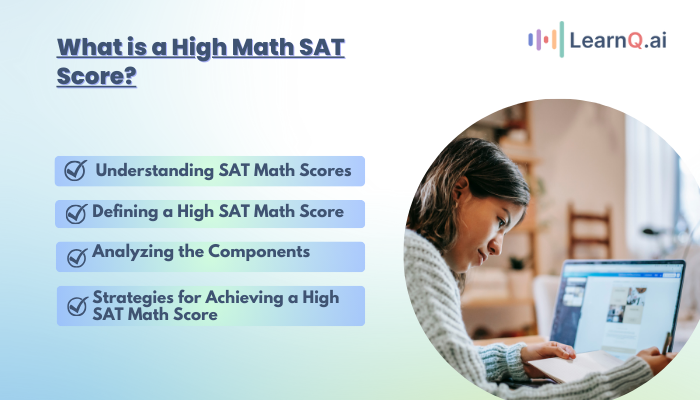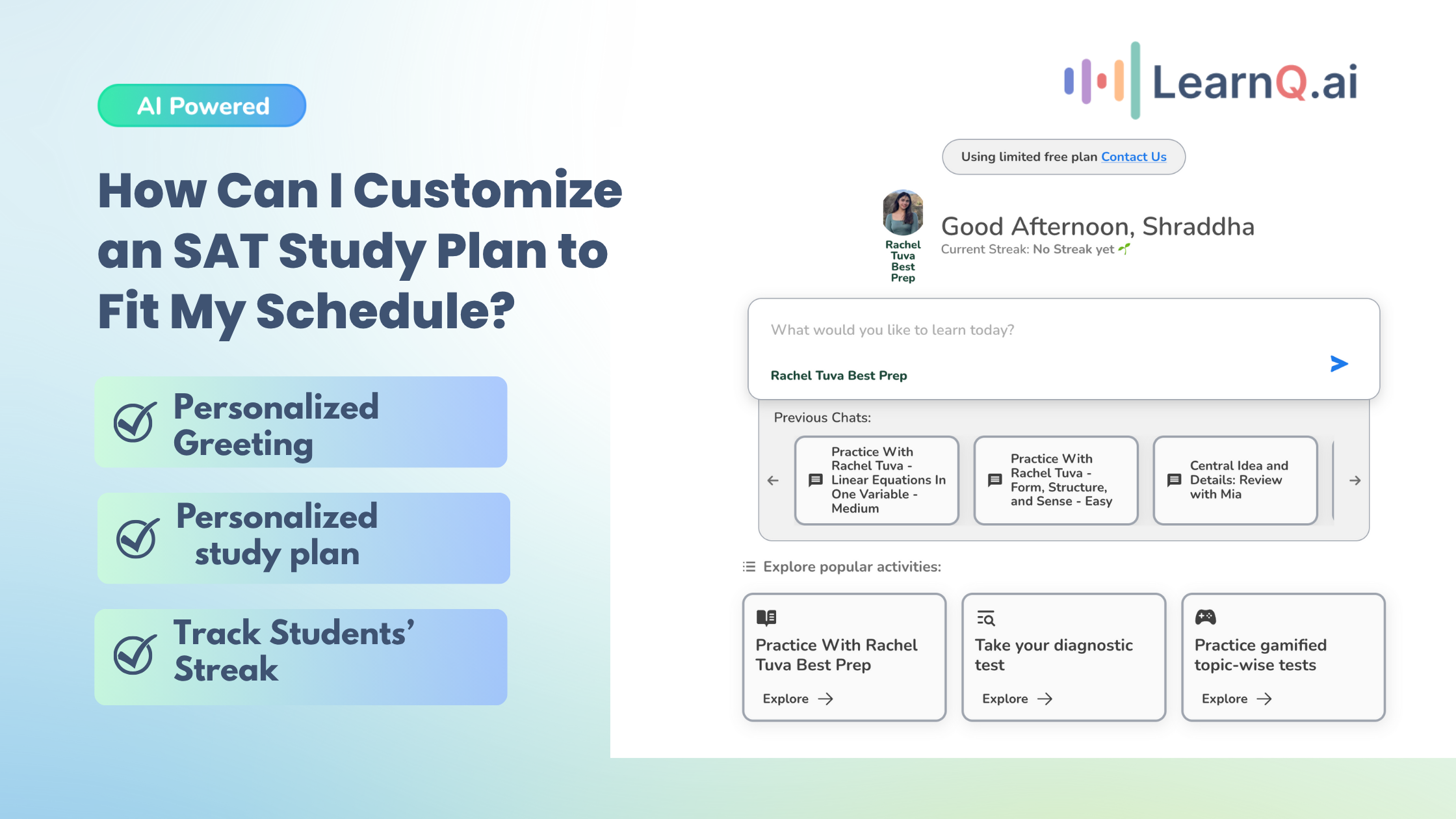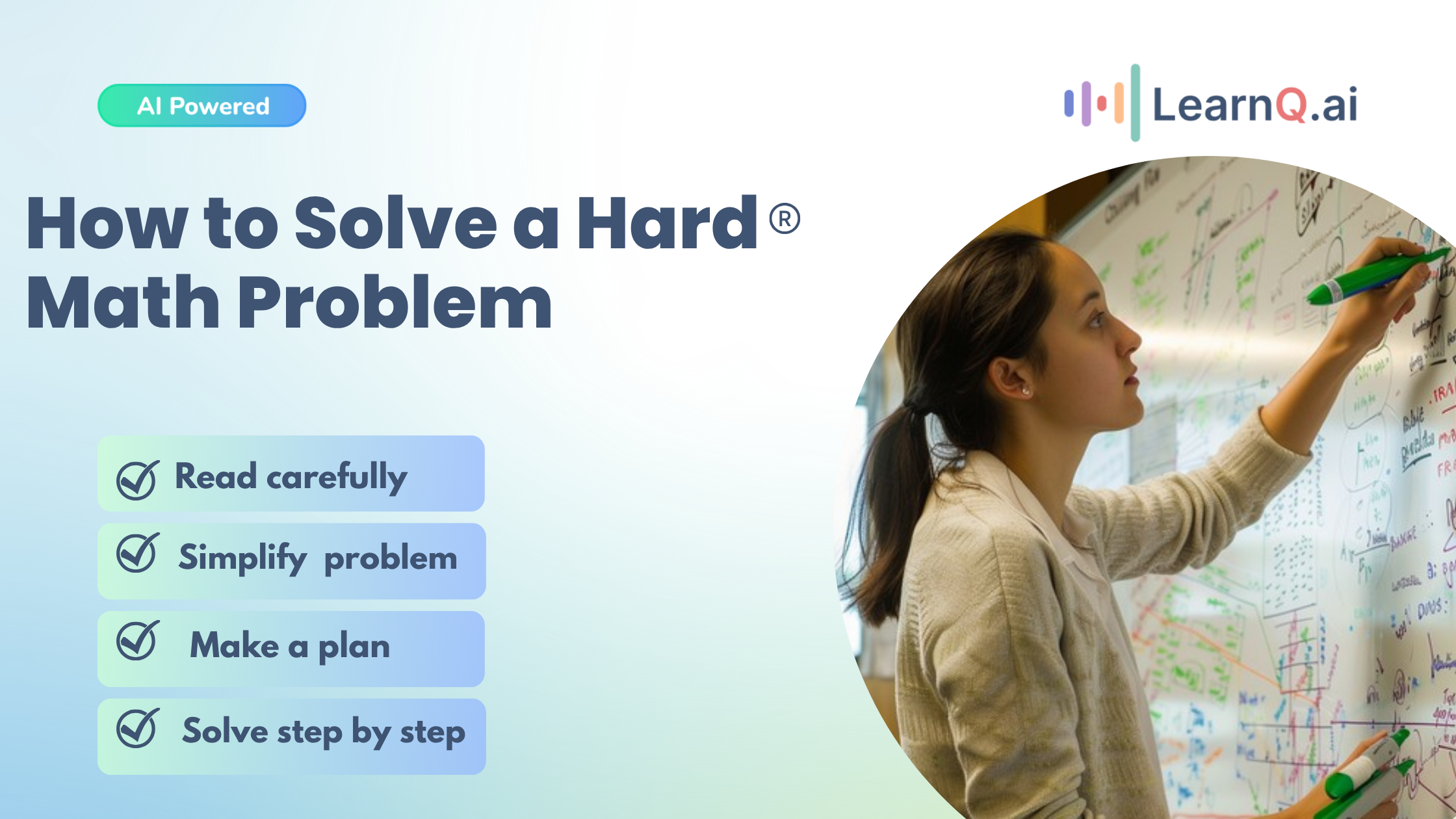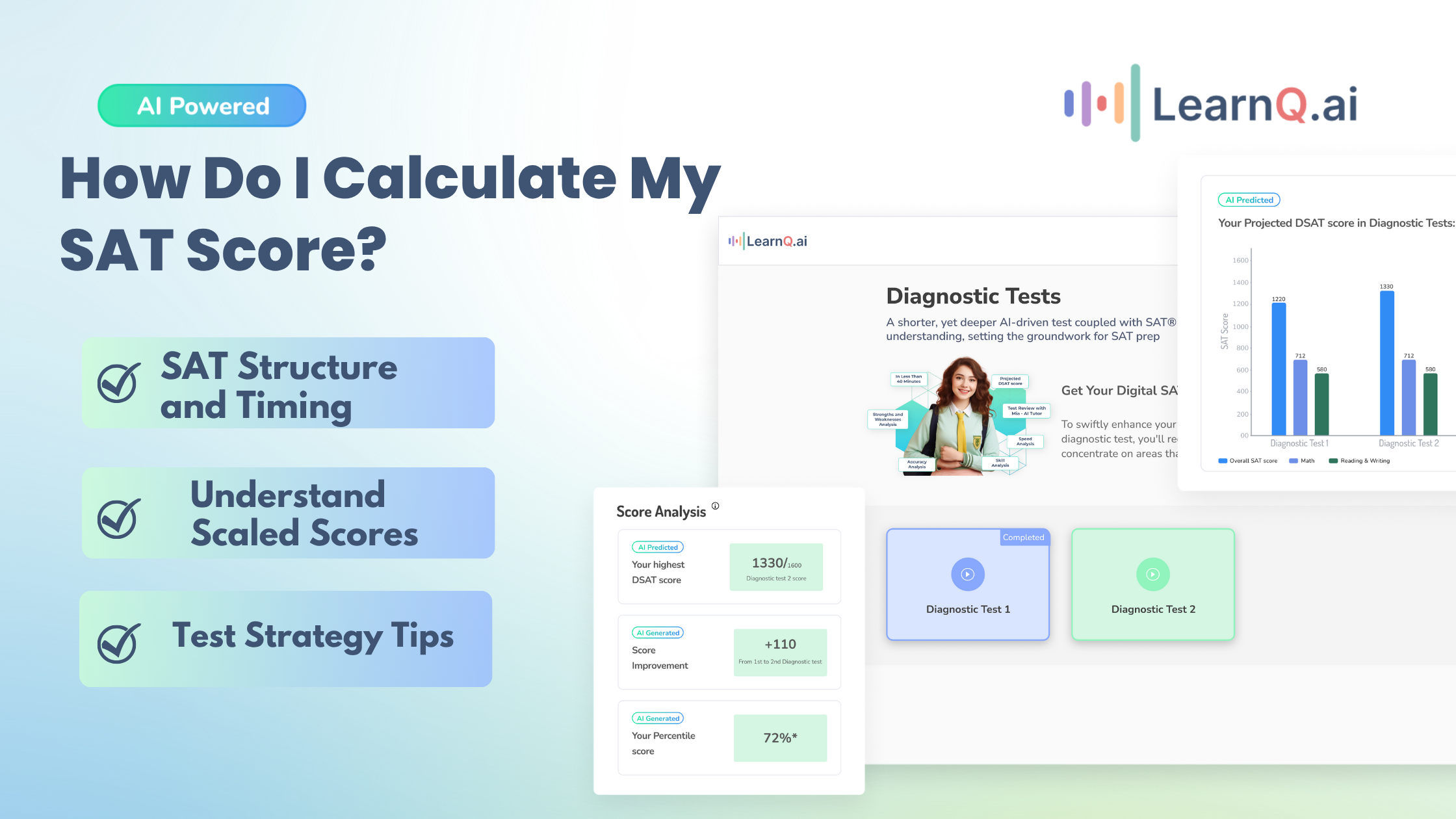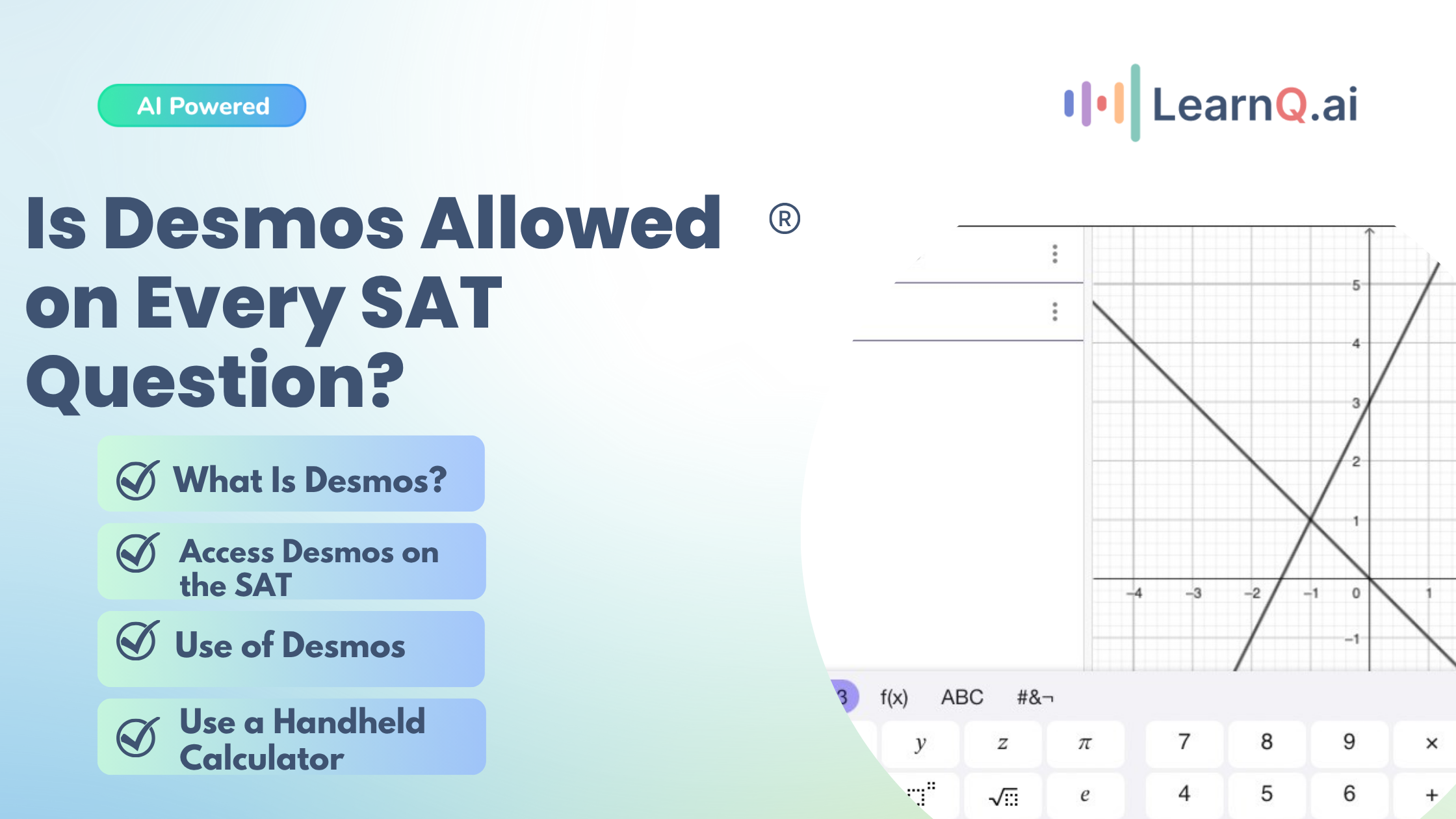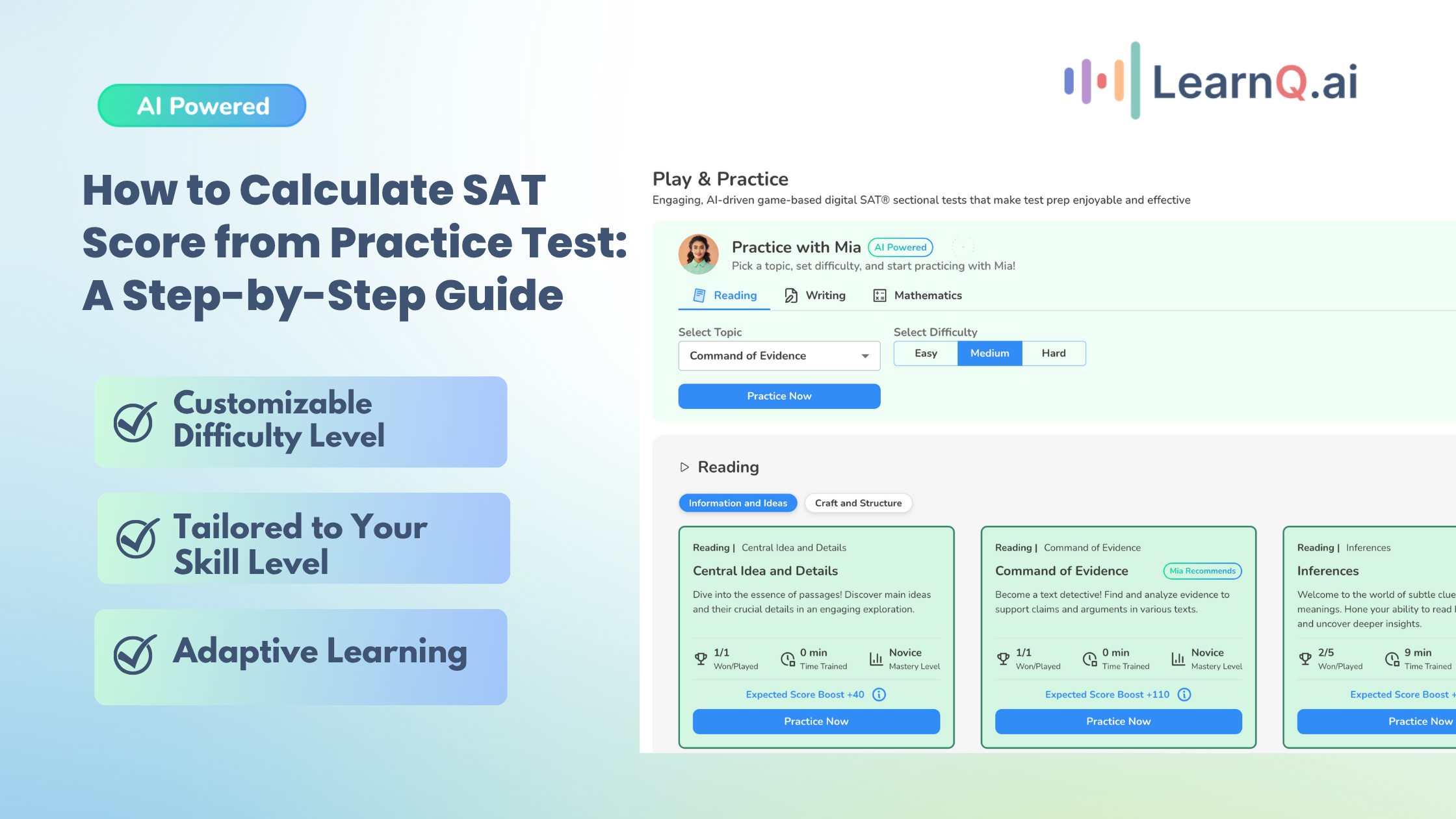Scoring well on the SAT Math section can open doors to a wide range of academic and scholarship opportunities, especially for students interested in competitive programs. Colleges use SAT Math scores as an objective measure of your mathematical understanding and problem-solving skills.
Whether you’re aiming for a STEM field, liberal arts, or business degree, performing well in SAT Math demonstrates quantitative reasoning and logical thinking, which are critical skills in nearly all fields.
LearnQ.ai is Powered by VEGA AI—Is your Institute Next?
Give students a Duolingo-style test-prep platform with Shopify-level customization for tutors and institutes.
Definition of the SAT Math Section and Its Significance
The SAT Math section is one of the two core parts of the SAT exam, alongside the Evidence-Based Reading and Writing section. It is designed to evaluate your grasp of key mathematical concepts and your ability to apply them in a timed exam setting. The Math section consists of two parts:
- Non-Calculator Section: 20 questions, 25 minutes
- Calculator Section: 38 questions, 55 minutes
Together, these two sections assess foundational topics such as algebra, geometry, and data analysis. However, they go beyond rote memorization, challenging you to apply concepts to solve real-world problems, use logic, and demonstrate quantitative reasoning skills. Here’s a breakdown of the topics covered:
- Heart of Algebra: Focuses on linear equations, inequalities, and functions.
- Problem Solving and Data Analysis: Covers ratios, percentages, and interpreting data in real-world contexts.
- Passport to Advanced Math: Tests your understanding of complex equations, such as quadratic and exponential functions.
- Additional Topics: Includes geometry, trigonometry, and concepts that may appear on college-level assessments.
A total SAT Math score ranges from 200 to 800, contributing up to half of the overall SAT score (400-1600). This means your performance in the Math section significantly impacts your composite SAT score, which colleges may use as part of their admissions criteria.
The Importance of Understanding What Constitutes a High Math Score
A “high” SAT Math score varies based on the colleges and programs to which you’re applying, but understanding score benchmarks can help you set a clear target. Here’s why understanding this benchmark matters:
- Competitive Advantage for Selective Colleges: For top-tier colleges, a math score of 700 or above (out of 800) can give you a competitive edge, especially for STEM-focused programs like engineering, computer science, or economics.
- Scholarship and Financial Aid Opportunities: Many merit-based scholarships and honors programs consider SAT scores and a strong math score can open doors to these financial resources. For instance, some universities have scholarship brackets tied to specific SAT score ranges, often above 650 in Math.
- College Placement and Remedial Courses: Colleges frequently use SAT Math scores to place students in courses. A high score could exempt you from remedial or introductory courses, allowing you to start directly with more advanced classes and potentially save on tuition costs.
- Impact on Composite SAT Score: Since the SAT Math section counts for half of your composite SAT score, a high math score can greatly increase your overall score. Many competitive colleges consider total SAT scores of 1400 or above as strong; achieving this score often requires excelling in both Math and Evidence-Based Reading and Writing.
- Setting Yourself Apart from Other Applicants: A strong SAT Math score showcases your quantitative skills, logical thinking, and attention to detail, all of which are valued in a variety of fields.
Enhance your Digital SAT study routine with AI-driven insights and personalized practice tests.
Also Read: The Benefits of Taking a Full-Length Digital SAT Mock Test
Understanding SAT Math Scores
Grasping how SAT Math scores work is essential for making the most of your test prep and boosting your college application. By breaking down the scoring system, understanding what percentile rankings mean, and knowing what a “high” score looks like, you’ll have a clear roadmap to achieving your target score.
1. Scoring Overview: Decoding the SAT Math Section
The SAT’s scoring system is designed to reflect your college readiness and is straightforward once you understand its breakdown. Here’s a detailed look:
The SAT Math Score Range
- Score Range: 200 to 800 points for the Math section alone.
- Total SAT Score Range: 400 to 1600 points, with Math making up 50%.
Structure of the SAT Math Section
The SAT Math section includes two parts: a Non-Calculator section and a Calculator section. Here’s what each entails.
| Section | Description | Time | Number of Questions | Key Skills Assessed |
| Non-Calculator Section | 20 questions requiring mental math, algebraic manipulation, and reasoning. | 25 minutes | 20 | Problem-solving, algebra, precision |
| Calculator Section | 38 questions covering more complex problems, often requiring data interpretation and strategic use of formulas. | 55 minutes | 38 | Advanced math, data analysis, multi-step problem-solving |
Combined, these sections evaluate core math skills, including:
- Heart of Algebra: Focuses on linear equations and inequalities.
- Problem Solving and Data Analysis: Tests your ability to interpret data and apply ratios, proportions, and percentages.
- Passport to Advanced Math: Assesses understanding of more complex functions, including quadratic and exponential.
Why This Matters: Colleges view the Math section as a predictor of your analytical skills and ability to tackle quantitative challenges, which are essential in any major. A solid performance in SAT Math signals to colleges that you’re ready for college-level coursework in math-heavy fields.
2. National Averages and Percentiles: How Your Score Stacks Up
National averages and percentiles help you measure your SAT Math score against other students, giving you a better sense of where you stand and what qualifies as a “high” score.
Average SAT Math Scores Over Recent Years
| Year | Average SAT Math Score |
| 2023 | 530 |
| 2024 | 532 |
| 2025 | 535 |
An average Math score hovers around 530, which means that scoring above this places you ahead of half of all test-takers. Knowing the average gives you a baseline to aim above if you want to increase your chances with selective colleges.
Percentile Rankings and Score Interpretation
Percentiles provide another layer of insight, showing you where your score places you relative to other test-takers.
| Math Score | Approximate Percentile | Score Interpretation |
| 700-800 | 90th – 99th Percentile | Top-Tier: Highly competitive score; suitable for Ivy League and other selective programs, especially in STEM. |
| 600-690 | 75th – 89th Percentile | Above Average: A solid score for most universities and competitive for mid-tier STEM, business, and economics programs. |
| 500-590 | 50th – 74th Percentile | Average: Meets the standard for many schools but may limit opportunities in top programs. |
| Below 500 | Below 50th Percentile | Below Average: Indicates room for improvement; may restrict options for selective institutions. |
What These Percentiles Mean for You:
- 90th Percentile and Above (700+): Scoring here places you among the top 10% of test-takers, which can make a strong impression on admissions committees, particularly for STEM or math-intensive majors.
- 75th-89th Percentile (600-690): This range is competitive for a broad range of programs, showing solid math skills that will stand out to admissions.
- 50th-74th Percentile (500-590): While still respectable, scores in this range may be less competitive for top programs but can be a solid showing for less selective colleges.
How Percentiles Influence Your Goals: Understanding your percentile can give you realistic targets. For example, if your dream school’s average SAT Math score is 650, aiming to be in the 75th percentile (600+) is a good goal that makes you competitive with their applicant pool.
Also Read: Digital SAT Practice Questions & Resources
Why Understanding SAT Math Scoring Matters for You
Knowing these averages and percentiles helps you set strategic goals and maximize your SAT Math score’s impact. If you’re aiming for competitive scholarships or selective programs, understanding these benchmarks allows you to prepare with purpose, knowing exactly what you need to achieve to stand out.
By using these insights to tailor your study plan, you can position yourself as a standout candidate ready for college-level challenges.
Defining a High SAT Math Score
Understanding what constitutes a “high” SAT Math score can help you gauge where your performance needs to be for specific colleges and programs. Here, we’ll break down typical benchmarks, examine how different institutions view these scores, and explore what factors affect the perception of a high score.
1. Score Benchmarks
A score in the SAT Math section of 700 or above is generally considered high, putting you in a strong position for many competitive programs. However, the definition of “high” can shift depending on the selectivity of the school you’re applying to.
Typical High Score Ranges
Here’s a breakdown of how SAT Math scores generally stack up against admission expectations.
| Score Range | General Interpretation | Suitable For |
| 700-800 | Excellent; represents top 10-15% of test-takers | Highly selective colleges (Ivy League, MIT) |
| 600-690 | Above average; competitive for most colleges | Competitive mid-tier universities and STEM programs |
| 500-590 | Average; meets basic admission standards | Less selective colleges and programs |
High SAT Math Scores by College Admission Standards
Let’s look at some specific examples of colleges and the SAT Math scores that are typical among admitted students.
| College | Average Admitted SAT Math Score |
| Massachusetts Institute of Technology (MIT) | 780 |
| Harvard University | 740-780 |
| University of Michigan | 650-720 |
| University of Florida | 610-670 |
| Arizona State University | 550-600 |
These ranges highlight how certain schools prioritize a high Math score, especially for STEM programs, while others may set a lower threshold, focusing on a holistic view of your overall profile.
2. Factors Influencing Perceptions of a High Score
What makes an SAT Math score “high” is not just the number but also the context in which it’s viewed. Here’s how different factors affect the perception of what’s considered high:
Variability by College Selectivity
The level of selectivity in college admissions plays a major role in how SAT Math scores are evaluated. For instance:
- Highly Selective Colleges (e.g., Ivy League, Stanford): These institutions expect scores near the top of the scale, often above 750 for math-focused programs.
- State Universities and Less Selective Colleges: These schools often admit students with a broader range of scores, and a Math score of around 600 might still be seen as competitive.
The Role of SAT Math in Overall Scores and GPA
For some colleges, SAT Math is weighted as part of the composite SAT score, while for others—especially those with math-intensive programs—it’s evaluated more closely. Keep in mind.
- STEM-Focused Programs: A strong Math score is crucial here, as it can reinforce your preparedness for technical courses. For engineering and computer science programs, an SAT Math score above 700 is often expected.
- Holistic Review: Many schools, particularly those with holistic admissions processes, consider your SAT Math score alongside GPA, extracurriculars, and essays. Here, the Math score supports your application rather than being a primary focus.
Impact of Other Standardized Tests
Admissions officers typically compare scores directly for students applying for both SAT and ACT scores.
- ACT Math Section: For students who submit the ACT instead, a comparable “high” ACT Math score would generally be 30 or above, reflecting similar competencies as a 700+ SAT Math score.
- Subject Tests or AP Scores: In addition to SAT or ACT, schools may consider high scores on AP exams in Calculus or Physics as supporting evidence of strong math skills, potentially offsetting slightly lower SAT Math scores.
Also Read: Tips for Solving Problems on SAT Practice Test With Study Plan
Analyzing the Components of a High SAT Math Score
To reach a high score on the SAT Math section, you’ll need to master specific content areas and avoid common pitfalls that can lower your score. Here’s how to focus your study efforts effectively.
1. Key Concepts Assessed
The SAT Math section covers several content areas designed to test a range of mathematical skills. Here’s a simplified look at each area.
SAT Math Content Areas:
- Heart of Algebra: Focuses on linear equations, inequalities, and systems. Essential for building foundational math skills.
- Problem Solving and Data Analysis: Tests your ability to interpret data and apply ratios and percentages, which are vital for solving real-world problems.
- Passport to Advanced Math: Involves complex functions and higher-level algebra, requiring a deeper understanding for those aiming for top scores.
- Additional Topics: Includes geometry and trigonometry, such as area, volume, and right triangles. These questions can be challenging but offer opportunities to gain extra points.
Why Mastering These Matters: Each content area contributes to your ability to solve different types of questions:
- Mastery of algebra helps with problem-solving and multi-step questions.
- Comfort with data analysis is key for navigating complex data sets quickly.
- Advanced math skills are crucial for tackling higher-difficulty questions, especially for scores above 700.
- Geometry and trigonometry provide opportunities for additional points that can make a difference in your final score.
Enhance your Digital SAT study routine with AI-driven insights and personalized practice tests.
2. Common Pitfalls in SAT Math
Avoiding common mistakes is as crucial as mastering the content. Here are the top pitfalls students face and how you can avoid them:
Common SAT Math Pitfalls and How to Avoid Them:
- Misreading Questions: Students often rush and misinterpret what the question is asking.
- Fix: Slow down, underline key terms, and double-check what the question requires before solving.
- Overusing the Calculator: While the Calculator section allows its use, relying too heavily can waste time and lead to errors.
- Fix: Use mental math for simpler calculations and reserve the calculator for more complex equations.
- Skipping Steps: Rushing through algebraic steps can lead to small errors that affect the solution.
- Fix: Write down key steps, even briefly, to track your process and reduce the chance of mistakes.
- Forgetting Formulas: Misapplying or forgetting formulas is common, especially in geometry.
- Fix: Memorize key formulas before test day and practice using them in different contexts to build familiarity.
- Poor Time Management: Getting stuck on difficult questions can lead to insufficient time for easier problems.
- Fix: Skip challenging questions initially and return to them after completing the easier ones to maximize your score potential.
Key Strategies:
- Practice Active Reading: Focus on understanding each question thoroughly before diving into calculations.
- Prioritize Accuracy Over Speed: It’s better to answer fewer questions correctly than rush through and make errors.
- Regular Practice: Work on a variety of problem types to strengthen your familiarity with different question formats.
Read More: What is the Highest Score on ACT and SAT Tests?
Strategies for Achieving a High SAT Math Score
Achieving a high SAT Math score requires a mix of consistent study habits, effective practice techniques, and smart use of resources like LearnQ.ai.
This adaptive learning platform is designed to enhance your study experience through personalized learning paths, targeted practice, and in-depth analytics to ensure you’re tackling the areas that need the most improvement.
1. Effective Study Habits
Building strong study habits is foundational to success in the SAT Math section. Here’s how to structure your study routine effectively:
- Consistent Practice with a Schedule: Regular study sessions are far more effective than cramming, as they help reinforce concepts over time. Aim to practice SAT Math 3-4 times a week, dedicating shorter, focused sessions rather than marathon study periods.
- Use Quality Study Materials with LearnQ.ai: With LearnQ.ai, you get access to a robust range of practice questions and tools designed specifically for SAT Math. The platform helps break down each topic—from algebra to advanced math—and tailors practice sessions to your unique learning needs.
LearnQ.ai Features
- Personalized Study Plans: LearnQ.ai assesses your strengths and weaknesses and creates a custom study plan to maximize your study efficiency.
- Interactive Practice: Engage with interactive questions that provide instant feedback, helping you learn from each question.
- Performance Analytics: Track your progress with detailed analytics that show your growth in specific areas.
- Adaptive Learning: LearnQ.ai dynamically adjusts your study path based on your performance, focusing on areas where you need the most practice to boost your score effectively.
How LearnQ.ai Supports Effective Study Habits: With tailored study plans and instant feedback, LearnQ.ai helps you optimize each study session, ensuring you’re always working on the concepts that will most impact your SAT Math score.
2. Practice Techniques
Strategic practice is key to building confidence and pacing skills for the SAT Math section. Here’s how LearnQ.ai can enhance your practice routine:
- Real SAT Practice Questions: LearnQ.ai provides authentic SAT Math questions, ensuring you’re familiar with the types of problems you’ll face on test day. By working with these questions, you develop comfort with SAT formats and difficulty levels, minimizing surprises on the actual exam.
- Timed Practice Tests with LearnQ.ai: LearnQ.ai’s platform offers timed testing simulations that mimic real SAT conditions. Practicing under timed settings builds your stamina, improves pacing, and helps you manage time constraints. The simulated environment prepares you to feel confident and calm when the clock is ticking on test day.
- In-Depth Review of Mistakes: Reviewing missed questions is one of the most valuable parts of practice. With LearnQ.ai’s performance analytics, you can identify patterns in your mistakes and target specific areas for improvement. LearnQ.ai also offers detailed solutions so you understand not just the correct answer but also the steps needed to get there.
Tips for Maximizing Practice with LearnQ.ai:
- Set Targeted Goals: Use LearnQ.ai to set focused goals for each session. For instance, work on problem solving and data analysis in one session, then review your progress.
- Track Progress with Analytics: LearnQ.ai’s analytics lets you monitor improvements by topic, helping you see exactly where you’re advancing and where you may need more practice.
- Simulate the Real Test: Regularly take full-length, timed practice exams on LearnQ.ai to get comfortable with real test conditions.
By using LearnQ.ai’s adaptive tools and analytics, you gain a customized study experience that strengthens your SAT Math performance efficiently. The platform’s targeted approach ensures that every session is productive, helping you achieve the highest possible score on test day.
LearnQ.ai is powered by VEGA AI—Is your institute next?
Offer students a Duolingo-style test-prep platform with Shopify-level customization for tutors and institutes.






Conclusion
Achieving a high SAT Math score involves more than just understanding math concepts; it requires effective study habits, targeted practice, and familiarity with the SAT format.
A high score, generally 700 or above, demonstrates your readiness for college-level challenges and can significantly boost your application to competitive programs, especially in STEM fields.
To reach your full potential, it’s essential to prepare with strategies tailored to your individual strengths and weaknesses.
LearnQ.ai provides the perfect solution with its adaptive learning platform, which customizes your study path, focuses on your areas for improvement, and offers real Full-length SAT Practise Tests through interactive questions and timed testing.
If you’re ready to elevate your SAT Math preparation, explore LearnQ.ai’s comprehensive study resources and build a study plan that works for you.
Start today and take the first step toward achieving your target score!

